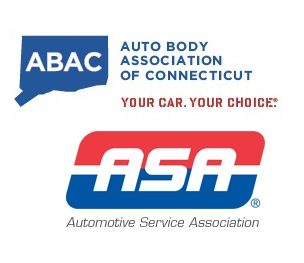
ABAC, ASA on opposite sides of N.H. auto body repair procedures bill
By onAssociations | Business Practices | Insurance | Legal | Repair Operations
The Auto Body Association of Connecticut’s recent opposition to a bill demanding insurers reimburse auto body shops for any repairs done per OEM “procedures, recommendations, or service bulletins” puts it at odds with the Automotive Service Association on the issue.
House Bill 664 follows a Nov. 1, 2018, report by a committee tasked by 2018’s House Bill 1663 to study collision repair reimbursements and present findings to state leaders. One of the committee’s members, state Rep. Kermit Williams, D-Wilton, sponsored the new HB 664, as did a mix of other senators and representatives.
The new HB 664 would add a single sentence to New Hampshire statutes: “An insurer shall reimburse a repairer for all repairs if a repairer follows original equipment manufacturer recommended collision repair procedures, recommendations, or service bulletins while repairing a vehicle. ” The law would kick in 60 days after passage.
HB 664 is one of the pieces of legislation within the ASA and Alliance of Automobile Manufacturers’ push this session to enshrine OEM repair procedures into state laws. ASA lobbyist Robert Redding Jr. said Tuesday the effort also has seen the Alliance of Automotive Service Providers pursue a related bill in Minnesota and received support from the Society of Collision Repair Specialists. (SCRS doesn’t actively involve itself in state legislation, though.)
“House Bill 664 addresses an issue of concern for consumers and repairers,” Redding wrote to the New Hampshire House Committee on Commerce and Consumer Affairs on Jan. 28. “The Seebachan v. John Eagle Collision Center decision reminded collision repairers of the importance of having proper repair procedures. The original equipment manufacturers’ (OEM) repair procedures are the logical repair processes to be followed. … ASA’s interest is in requiring the industry to adhere to a set of repair procedures that assure the best opportunity for vehicle safety on our highways. House Bill 664 calls for vehicle repair standards requiring insurers’ ‘reimburse a repairer for all repairs if a repairer follows original equipment manufacturer recommended collision repair procedures, recommendations, or service bulletins while repairing a vehicle’. This legislation ensures that the State of New Hampshire has done as much as possible to protect consumers and small businesspersons in the repair chain following an accident.
“… All segments of the collision repair industry should support quality, safe repairs. Establishing a baseline of expected repair procedures is a step towards quality, safe repairs for the motoring public.”

SCRS, ASA and the AASP have for years declared OEM repair procedures to be the standard of care when fixing a customer’s vehicle. I-CAR, the nationally recognized industry educational provider, also says manufacturer repair procedures supercede anything it teaches. Courts also affirm this position, perhaps most famously in the $31.5 million John Eagle verdict (later settled for an undisclosed amount).
However, insurers have been known to refuse to reimburse procedures in spite of this, placing a collision repairer in the unfortunate position of a) eating the cost of the work, b) billing the customer for the difference, or c) not performing the required work correctly or at all and opening up a potentially multimillion-dollar world of liability.
ABAC said the New Hampshire’s effort’s heart was in the right place but language relating to insurers paying shops confused the actual repairer-customer-insurer relationship.
The insurer technically has no role in the repair process. The shop’s contract and duty — even a DRP shop’s contract and duty — is with the vehicle owner, and the owner in turn owes the shop for the work. The vehicle owner or at-fault party’s contract is with the insurer, and the insurer/at-fault party owes the vehicle owner for the cost of the repair.
“The Auto Body Association of Connecticut (ABAC) agrees in concept with reforms that would make the utilization of OEM repair procedures more widely used and reimbursed,” ABAC wrote. “Ultimately, however, we have concerns about the framework of New Hampshire’s House Bill 664. Insurance companies are legally obligated to indemnify their insureds or the victims of their insureds. Creating language that would make an insurer directly obligated to pay an auto body repairer misunderstands the dynamics of the relationship and each party’s respective obligations. This is problematic because it suggests that insurers should have a greater degree of control in the repair process, something we have fought for many years.”
Collision repair attorney Erica Eversman and former shop owner Wade Ebert said at a SEMA 2018 talk an insurer has three options: Reimburse the customer for the cost of the repair, total the car and pay for it or elects to oversee the repair process as a contractor — which sticks them with all liability and so will never be the carrier’s choice, Eversman and Ebert said. Choosing to reimburse the customer means the insurer has no say in how the vehicle is repaired.
Eversman said that even lawyers and judges get confused by the reality the insurer has no role in a repair unless it actually elects to handle the repair itself. “They just don’t get it,” she said.
“The reimbursement for the identified services is something an insurer would already be legally obligated to do,” ABAC wrote. “The reimbursement structure contemplated in the original draft language suggests that an insurer would owe a duty to directly indemnify a repair facility when, in fact, that duty is actually owed to its insured or the insured’s victim. Thus, it makes no sense to legislate a duty to make direct payment from an insurer to an auto repair facility, which is the primary basis for our objection.”
“I do understand their argument,” Redding said in an interview Tuesday, but said the ASA supported addressing the issue as simply as possible. Follow OEM procedures, and “you get paid,” he described it later.
“We need this done,” he said.
“I hear them,” Redding said of ABAC, but “we want to stick with the program.”
ABAC instead suggested language requiring shops to follow repair procedures: “An auto body repairer shall, whenever feasible, follow original equipment manufacturer recommended collision repair procedures, recommendations, or service bulletins when repairing a motor vehicle.”
Redding questioned the merit of the “whenever feasible” caveat in ABAC’s proposed language. He predicted insurers would seize upon it, claiming “‘There’s an exclusion,'” and refuse to pay the shop.
“I don’t know why they put that in there,” he said.
HB 664 was scheduled to have an executive session in the Commerce and Consumer Affairs Committee on Feb. 6. No other activity has been reported since.
Be heard: Contact information for New Hampshire lawmakers can be found here and here.
Images:
The New Hampshire Capitol is shown. (REKINC1980/iStock)
The Auto Body Association of Connecticut and Automotive Service Association logos are shown. (Provided by ABAC, ASA)
